GetStudySolution
Getstudysolution is an online educational platform that allows students to access quality educational services and study materials at no cost.
NCERT Solutions for class 9 Maths chapter 7 – Triangles
Back Exercise
Exercise 7.1
Question 1.
In quadrilateral ACBD, AC = AD and AB bisects ∠ A (see figure). Show that ∆ABC ≅ ∆ABD. What can you say about BC and BD?

Solution:
In ∆ABC and ∆ABD, we have
AC = AD (Given)
∠ CAB = ∠ DAB (∵ AB bisects ∠A)
and AB = AB (Common)
∴ ∆ ABC ≅ ∆ABD (By SAS congruence axiom)
∴ BC = BD (By CPCT)
Question 2.
ABCD is a quadrilateral in which AD = BC and ∠ DAB = ∠ CBA (see figure). Prove that
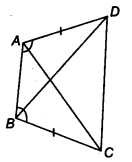
(i) ∆ABD ≅ ∆BAC
(ii) BD = AC
(iii) ∠ABD = ∠ BAC
Solution:
In ∆ ABC and ∆ BAC, we have
AD = BC (Given)
∠DAB = ∠CBA (Given)
and AB = AB (Common)
∴ ∆ ABD ≅ ∆BAC (By SAS congruence axiom)
Hence, BD = AC (By CPCT)
and ∠ABD= ∠BAC (By CPCT)
Question 3.
AD and BC are equal perpendiculars to a line segment AB (see figure). Show that CD bisects AB.
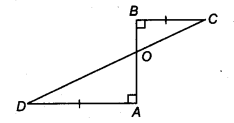
Solution:
In ∆AOD and ∆BOC, we have
∠AOD = ∠BOC
∵ AB and CD intersects at O.
∴ Which are vertically opposite angle
∵ ∠DAO = ∠CBO = 90°
and AD = BC (Given)
∴ ∆AOD ≅ ∆BOC (By SAS congruence axiom)
⇒ O is the mid-point of AB.
Hence, CD bisects AB.
Question 4.
l and m are two parallel lines intersected by another pair of parallel lines p and q (see figure). Show that ∆ABC = ∆CDA.
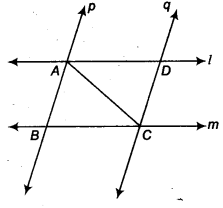
Solution:
From figure, we have
∠ 1 = ∠ 2 (Vertically opposite angles).. .(i)
∠ 1 = ∠ 6 (Corresponding angles)…(ii)
∠ 6 = ∠ 4 (Corresponding angles) …(iii)
From Eqs. (i) (ii) and (iii), we have
∠ 1 = ∠ 4
and ∠ 2 = ∠ 4 …..(iv)
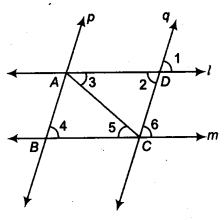
In ∆ABC and ∆CDA, we have
∠ 4 = ∠ 2 [From Eq. (iv]
∠5 = ∠ 3 (Alternate interior angles)
and AC = AC (Common)
∴ ∆ABC ≅ ∆ CDA (By AAS congruence axiom)
Question 5.
Line l is the bisector of an ∠ A and ∠ B is any point on l. BP and BQ are perpendiculars from B to the arms of LA (see figure). Show that
(i) ∆APB ≅ ∆AQB
(ii) BP = BQ or B is equidistant from the arms ot ∠A.
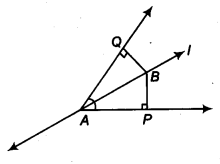
Solution:
In ∆ APB and ∆AQB, we have
∠ APB = ∠ AQB = 90°
∠ PAB = ∠ QAB (∵ AB bisects ∠ PAQ)
and AB = AB (Common)
∴ ∆ APB ≅ ∆ AQB (By AAS congruence axiom)
⇒ BP = BQ (By CPCT)
⇒ B is equidistant from the arms of ∠ A.
Question 6.
In figure, AC = AE, AB = AD and ∠BAD = ∠EAC. Show that BC = DE.
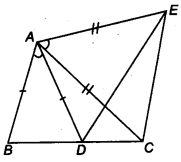
Solution:
In ∆ABC and ∆ADE, we have
AB = AD (Given)
∠ BAD = ∠ EAC (Given)…(i)
On adding ∠ DAC on both sides in Eq. (i)
⇒ ∠ BAD + ∠ DAC = ∠ EAC + ∠ DAC
⇒ ∠ BAC = ∠ DAE
and AC = AE (Given)
∴ ∆ABC ≅ ∆ADE (By AAS congruence axiom)
⇒ BC = DE (ByCPCT)
Question 7.
AS is a line segment and P is its mid-point. D and E are points on the same side of AB such that ∠ BAD = ∠ ABE and ∠ EPA = ∠ DPB. (see figure). Show that
(i) ∆DAP ≅ ∆EBP
(ii) AD = BE
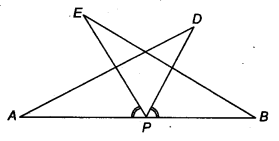
Solution:
We have,
AP = BP [∵ P is the mid-point of AB (Given)]… (i)
∠ EPA = ∠ DPB (Given)…(ii)
∠ BAD = ∠ ABE (Given).. .(iii)
On adding ∠ EPD on both sides in Eq. (ii); we have
⇒ ∠ EPA + ∠ EPD = ∠DPB + ∠ EPD
⇒ ∠ DP A = ∠ EPB …..(iv)
Now, In ∆DAP and ∆EBP, we have
∠ DPA = ∠ EPB [ From Eq(4)]
∠ DAP = ∠ EBP (Given)
and AP = BP [From Eq. (i)]
∴ ∆ DAP ≅ ∆ EBP (By ASA congruence axiom)
Hence, AD = BE (By CPCT)
Question 8.
In right triangle ABC, right angled at C, M is the mid-point of hypotenuse AB. C is joined to M and produced to a point D such that DM = CM. Point D is joined to point B (see figure). Show that
(i) ∆AMC ≅ ∆BMD
(ii) ∠DBC is a right angle
(iii) ∆DBC ≅ ∆ACB
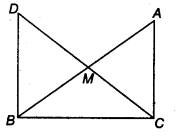
(iv) CM =
Solution:
Given ∆ACB in which ∠C = 90° and M is the mid- point of AB.

To prove (i) ∆ AMC = ∆ BMD
(ii) ∠DBC is a right angle
(iii) ∆DBC ≅ ∆ACB
(iv) CM =
Construction Produce CM to D, such that CM = MD. Join DB.
Proof In ∆ AMC and ∆ BMD, we have
AM = BM (M is the mid-point of AB)
CM = DM (Given)
and ∠AMC=∠BMD (Vertically opposite angles)
∴ ∆ AMC ≅ ∆ BMD (By SAS congruence axiom)
⇒ AC = DB (By CPCT) …(i)
and ∠1 = ∠2 (By CPCT)
Which are alternate angles
∴ BD || CA
Now, BD || CA and BC is transversal
∴ ∠ ACB + ∠CBD =180°
⇒ 90°+ ∠CBD = 180°
⇒∠CBD =90°
⇒ ∠ DBC = 90° [Which is part (ii)]
In ∆ DBC and ∆ ACB, we have
CB = BC (Common)
DB = AC [Using part (i)]
and ∠ CBD = ∠ BCA (Each 90°)
∴ ∆ DBC ≅ ∆ACB (By SSA congruence axiom) [Which is part (iii)]
⇒ DC=AB (by CPCT)
⇒
⇒ CM =
Exercise 7.2
Question 1.
In an isosceles triangle ABC, with AB = AC, the bisectors of ∠B and ∠C intersect each other at 0. Join A to 0. Show that
(i) OB = OC
(ii) AO bisects ∠A
Solution:
(i) In ∆ ABC, we have
AB = AC (Given)
⇒ ∠B = ∠C
(∵ Angles opposite to equal sides are equal)
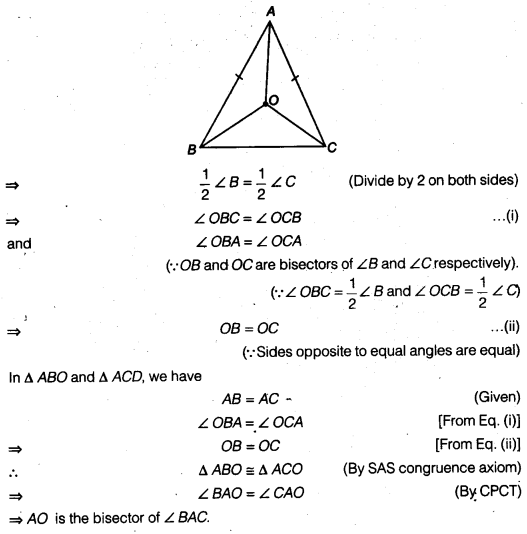
Question 2.
In ∆ ABC, AD is the perpendicular bisector of BC (see figure). Show that ∆ ABC is an isosceles triangle in which AB = AC.
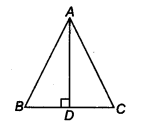
Solution:
In ∆ABD and ∆ACD, we have ,
DB = DC
∠ ADB = ∠ ADC (∵ D bisect SC)
and AD = AD (Common)
∴ ∆ ABD ≅ ∆ACD (By SAS congruence axiom)
⇒ AB = AC (By CPCT)
Renee,∆ ABC is an isosceles triangle.
Question 3.
ABC is an isosceles triangle in which altitudes BE and CF are drawn to equal sides AC and AB respectively (see figure). Show that these altitudes are equal.
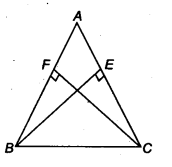
Solution:
In ∆ ABE and ∆ ACF, we have
∠ AEB = ∠ AFC (BE ⊥ AC, CF ⊥ AS, each 90°)
∠ A = ∠ A (Common)
and AS = AC (Given)
∴ ∆ABE ≅ ∆ACF (By AAS congruence axiom)
⇒ BE = CF (By CPCT)
Question 4. .
ABC is a triangle in which altitudes BE and CF to sides AC and AB are equal (see figure). Show that
(i) ∆ABE = ∆ACF
(ii) AB = AC i.e., ABC is an isosceles triangle.

Solution:
In ∆ABE and ∆ACF, we have
∠ AEB = ∠ AFC (Each 90°)
∠ BAE = ∠ CAF (Common)
and BE =CF (Given)
∴ ∆ABE ≅ ∆ACF (By AAS congruence axiom)
∴ AB = AC
So, ∆ABC is isosceles.
Question 5.
ABC and DBC are isosceles triangles on the same base BC (see figure). Show that ∠ ABD = ∠ACD.

Solution:
In ∆ABC, we have
AB=AC (∵ AABC is an isosceles triangle)
∴ ∠ ABC = ∠ ACB …(i)
(∵ Angles opposite to equal sides are equal)
In ∆ DBC, we have
BD = CD (∵ ADBC is an isosceles triangle)
∴ ∠ DBC = ∠ DCB …(ii)
(∵ Angles opposite to equal sides are equal)
On adding Eqs. (i) and (ii), we have .
∠ ABC + ∠ DBC = ∠ ACB + ∠ DCS
⇒ ∠ ABD = ∠ ACD
Question 6.
∆ABC is an isosceles triangle in which AB = AC. Side BA is produced to D such that AD = AB (see figure). Show that ∠ BCD is a right angle.
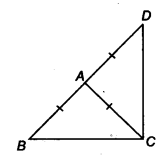
Solution:
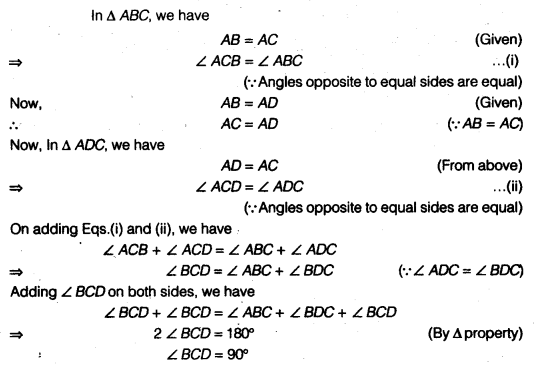
Question 7.
ABC is a right angled triangle in which ∠ A = 90° and AB = AC, find ∠ B and ∠ C.
Solution:
We have, ∠A = 90° (Given)
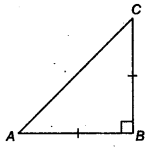
AB = AC (Given)
⇒ ∠B = ∠C
(∵ Angles opposite to equal sides are equal)
Now, we have
∠A+∠B+∠C = 180° (By ∆ property)
90° + ∠B+ ∠B = 180°
⇒ 2 ∠B = 90°
⇒ ∠B = 45°
∴ ∠B = ∠C = 45°
Question 8.
Show that the angles of an equilateral triangle are 60° each.
Solution:
Let ∆ ABC be an equilateral triangle, such that
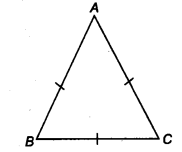
AB = BC = CA (By property)
Now, AB = AC
⇒ ∠B = ∠C …..(i)
(∵Angles opposite to equal sides are equal)
Similarly, CB = CA
⇒∠A = ∠B …(ii)
(∵ Angles opposite to equal sides are equal)
From Eqs. (i) and (ii), we have
∠A=∠B=∠C …(iii)
Now, ∠A+ ∠B+ ∠C = 180° (By ∆ property)
∠A + ∠A + ∠A = 180° [From Eq. (iii)]
3 ∠A = 180°
∠A = 60°
Hence, ∠ A = ∠B = ∠C = 60°
Exercise 7.3
Question 1.
∆ABC and ∆DBC are two isosceles triangles on the same base BC and vertices A and D are on the same side of BC (see figure). If AD is extended to intersect BC at P, show that
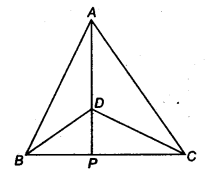
(i) ∆ABD = ∆ACD
(ii) ∆ABP = ∆ACP
(iii) AP bisects ∠A as well as ∠D
(iv) AP is the perpendicular bisector of BC.
Solution:
Given ∆ABC and ∆DBC are two isosceles triangles having common
base BC, suchthat AB=AC and DB=OC.
To prove:
(i) ∆ABD = ∆ACD
(ii) ∆ABP = ∆ACP
(iii) AP bisects ∠A as well as ∠D
(iv) AP is the perpendicular bisector of BC.

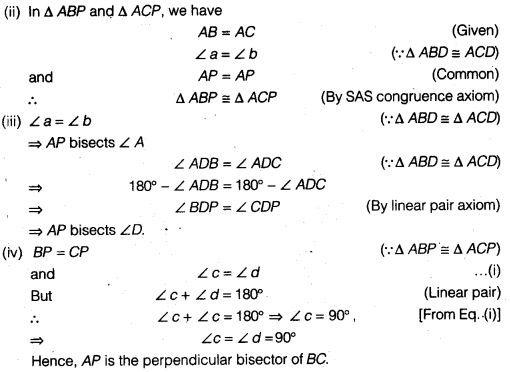
Question 2.
AD is an altitude of an isosceles triangle ABC in which AB = AC. Show that
(i) AD bisects BC
(ii) AD bisects ∠A
Solution:
In ∆ ABD and ∆ ACD, we have
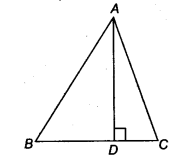
AB = AC (Given)
∠ADB = ∠ADC = 90° (∵ Given AD ⊥BC)
AD = AD (Common)
∴ ∆ ABD ≅ ∆ ACD (By RHS congruence axiom)
BD=DC (By CPCT)
⇒ AD bisects BC.
∠ BAD = ∠ CAD (By CPCT)
∴ AD bisects ∠A .
Question 3.
Two sides AB and BC and median AM of one triangle ABC are respectively equal to sides PQ and OR and median PN of ∆PQR (see figure). Show that
(i) ∆ABC ≅ ∆PQR
(ii) ∆ABM ≅ ∆PQN
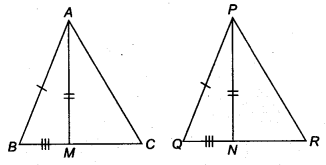
Solution:
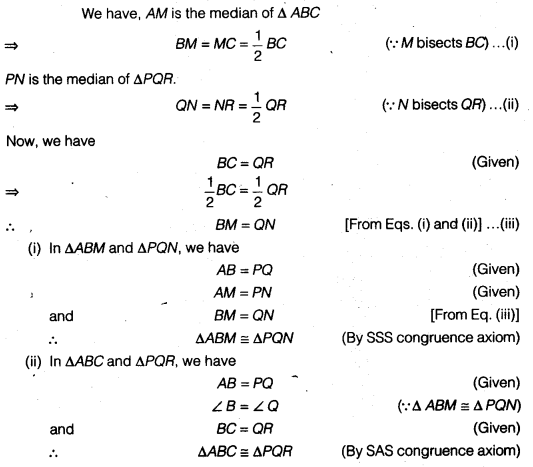
Question 4.
BE and CF are two equal altitudes of a triangle ABC. Using RHS congruence rule, prove that the triangle ABC is isosceles.
Solution:
In ∆BEC and ∆CFB, we have
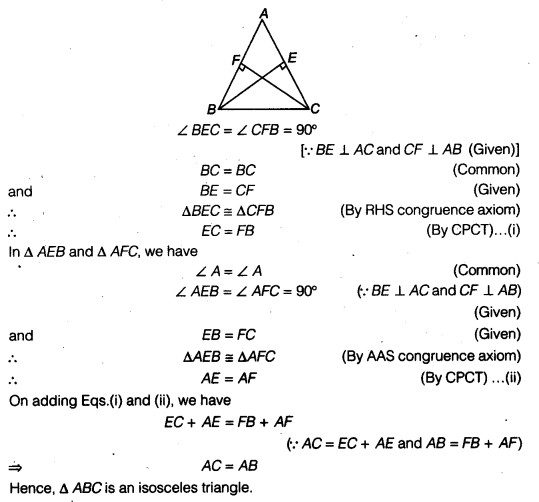
Question 5.
ABC is an isosceles triangle with AB = AC. Draw AP ⊥ BC to show that ∠B = ∠C.
Solution:
In ∆ABP and ∆ACP, We have
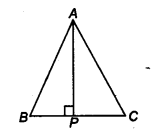
AB = AC (Given)
AP = AP (Common)
and ∠APB = ∠APC = 90° (∵ AP ⊥ BC)
∴ ∆ABP ≅ ∆ACP (By RHS congruence axiom)
⇒ ∠B = ∠C (By CPCT)
Exercise 7.4
Question 1.
Show that in a right angled triangle, the hypotenuse is the longest side.
Solution:
Let ABC be a right angled triangle, such that ∠ ABC = 90°
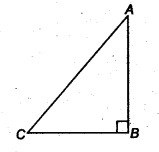
We know that,
∠ABC + ∠BCA + ∠CAB = 180° (By A property)
⇒ 90° + ∠BCA + ∠CAB = 180°
⇒ ∠BCA + ∠CAB = 90°
From above, we have ∠ BCA and ∠ CAB are acute angles.
⇒ ∠BCA < 90°
and ∠CAB < 90°
⇒ ∠BCA < ∠ABC
and ∠CAB < ∠ABC
⇒ AB < AC and BC < AC (∵ Side opposite to greater angle is longer)
Hence, the hypotenuse (AC) is the longest side.
Question 2.
In figure, sides AB and AC of ∆ABC are extended to points P and Q respectively. Also, ∠PBC < ∠QCB. Show that AC > AB.
Solution:
We know that,
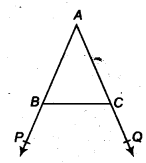
∠ACB + ∠QCB = 180° (Linear pair)…(i)
and ∠ABC+ ∠PBC = 180° (Linear pair)…(ii)
From Eqs. (i) and (ii), we have
∠ABC + ∠PBC = ∠ACB + ∠QCB ….(iii)
But ∠PBC < ∠QCB (Given)…(iv) From Eqs. (iii) and (iv), we have ∠ ABC > ∠ ACB
⇒ AC > AB
(∵ Side opposite to greater angle is longer)
Question 3.
In figure, ∠B <∠ A and ∠C <∠ D. Show that AD < BC.
Solution:

Question 4.
AB and CD are respectively the smallest and longest sides of a quadrilateral ABCD (see figure). Show that ∠ A> ∠C and ∠B > ∠D.
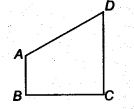
Solution:
Given ABCD is a quadrilateral. AB is the smallest side and CD is the longest side.
To prove ∠A > ∠C and ∠B > ∠D
Construction Join A to C and B to D.
Proof In ∆ABC, we have AB is the smallest side.
∴ AB < BC
⇒ ∠5 < ∠1
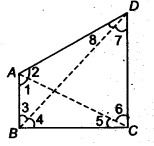
(∵ Angle opposite to longer side is greater) …(i)
In ∆ADC, we have CD is the largest side.
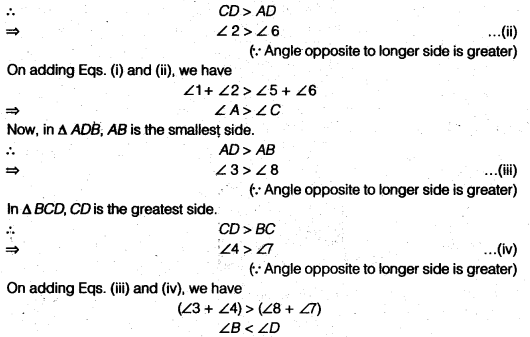
Question 5.
In figure, PR > PQ and PS bisect ∠QPR. Prove that
∠PSR >∠PSQ.
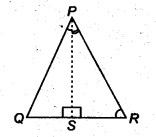
Solution:
In ∆ PQR, we have
PR > PQ (Given)
⇒ ∠ PQR > ∠ PRQ …(i)
(∵ Angle opposite to longer side is greater)
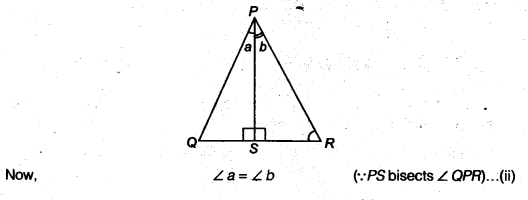
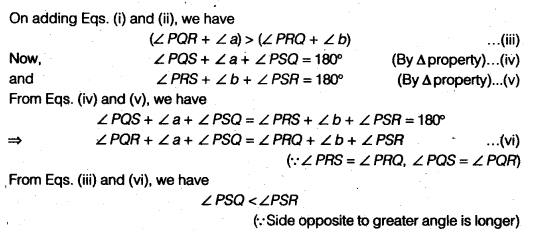
Question 6.
Show that of all line segments drawn from a given point not on it, the perpendicular line segment is the shortest.
Solution:
Given x is a line and A is a point not lying on x. AB ⊥ x, Cis any point on x other than B.
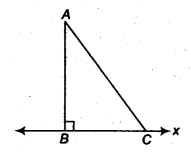
To prove AB∠C
⇒ AC> AB
(∵ the Side opposite to greater angle is longer)
⇒ AB < AC
Hence, the perpendicular line segment is the shortest.
Exercise 7.5
Question 1.
ABC is a triangle. Locate a point in the interior of ∆ ABC which is equidistant from all the vertices of ∆ ABC.
Solution:
Suppose OM and ON be the perpendicular bisectors of sides BC and AC of ∆ ABC.
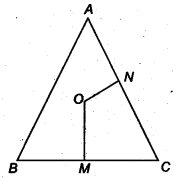
So, O is equidistant from two endpoints 0 and C of line segment BC as O lies on the perpendicular bisector of BC. Similarly, O is equidistant from C and A Hence, O be an orthocentre of ∆ABC.
Question 2.
In a triangle locate a point in its interior which is equidistant from all the sides of the triangle.
Solution:
Suppose BN and CM be the bisectors of ∠ ABC and ∠ ACB, respectively intersect AC and AB at N and M, respectively.
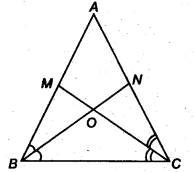
Since, O lies on the bisector BN of ∠ ABC, so O will be equidistant from BA and BC. Again, O lies on the bisector CM of ∠ ACB.
So, O will be equidistant from CA and BC. Thus, O will be equidistant from AB, BC and CA Hence, O be a circumcentre of ∆ABC.
Question 3.
In a huge park, people are concentrated at three points (see figure)
A: where these are different slides and swings for children.
B: near which a man-made lake is situated.
C: which is near to a large parking and exist.
Where should an ice-cream parlor be set? up so that maximum number of persons can approach it?
[Hint The parlour should be equidistant from A, B and C.]

Solution:
The ice-cream parlor should be equidistant from A B and C for which the point of intersection of perpendicular bisectors of AB, BC, and CA should be situated.
So, O is the required point which is equidistant from A B and C.
Question 4.
Complete the hexagonal and star shaped Rangolies [see Fig. (i) and (ii)] by filling them with as many equilateral triangles of side 1 cm as you can. Count the number of triangles in each case. Which has more triangles?
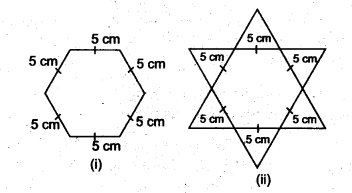
Solution:
We first divide the hexagon into six equilateral triangles of side 5cm as follow.
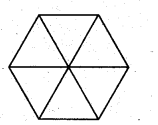
We take one triangle from six equilateral triangles as shown above and make as many equilateral triangles of one side 1 cm as shown in the figure.
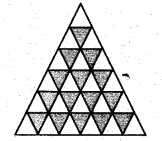
The number of equilateral triangles of side 1 cm = 1 + 3 + 5 + 7 + 9 = 25
So, the total number of triangles in the hexagon = 6x 25 = 150
To find the number of triangles in the Fig. (ii), we adopt the same procedure.
So, the number of triangles in the Fig. (ii) = 12 x 25 = 30Q Hence, Fig. (ii) has more triangles.